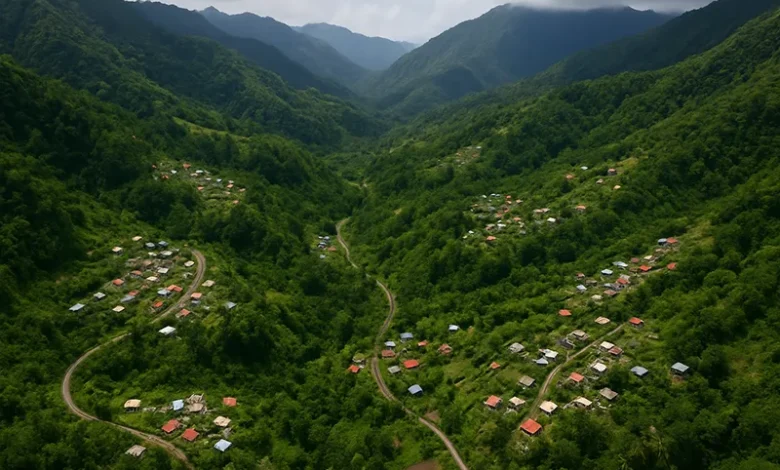Rural Communities in Dominica

Rural Communities in Dominica are home to the majority of the island’s population and serve as vital engines of agriculture, culture, and local governance. Spread across steep valleys, coastal plains, and rugged landscapes, these Dominican communities reflect the country’s deep-rooted connection to land, heritage, and self-reliance. Their character is shaped by colonial history, migration patterns, infrastructure development, and modern social shifts that continue to influence their daily lives.
Historical Formation and Settlement Patterns
Dominica’s rural communities trace their roots to the post-emancipation period, when freed African-descended populations moved inland to establish independent villages on mountainous terrain. Many of these settlements began as small provision grounds, eventually formalizing into villages, hamlets, and estates. The displacement of Kalinago people to the eastern reserve and the gradual retreat of colonial estate owners in the late 19th century further expanded access to rural land.
During the 20th century, the government introduced the Land Settlement Scheme, which encouraged development in areas such as Sylvania, Warner, and Morne Prosper. These programs helped regularise holdings and expand village infrastructure. Some communities grew around banana and citrus plantations, such as Wesley and Belles, while others, like Grand Fond and La Plaine, evolved through subsistence farming and fishing.
Dominica’s rugged landscape divides its rural settlements into coastal and interior categories. Coastal villages such as Scotts Head, Calibishie, and Woodford Hill line the island’s edge and often depend on fishing and tourism. In contrast, interior communities like Eggleston and Penrice are situated in rainforest valleys or on mountain slopes and rely heavily on farming.
Most rural areas fall within Dominica’s ten administrative parishes, with notable clusters in Saint Joseph (e.g., Coulibistrie, Belles), Saint David (e.g., Morne Jaune, Riviere Cyrique), and Saint Patrick (e.g., Bellevue Chopin, Pichelin). Access is often limited by narrow roads and river crossings, such as the D’Leau Gommier Bridge near Delices, which becomes impassable during heavy rainfall.
Rural life in Dominica reflects the island’s volcanic landscape: dramatic, beautiful, and often challenging to navigate. This isolation contributes to the preservation of creole language, traditional healing practices, and resilient social bonds that distinguish each locality.
Economy and Livelihoods
Agriculture remains the lifeblood of Dominica’s rural economy. Farmers in communities such as Marigot, Castle Bruce, and Penville cultivate dasheen, plantain, yams, ginger, and root crops, often under smallholder farming conditions. During the height of banana exports in the 1980s and 1990s, areas like Calibishie and Bagatelle prospered from British market access. However, the end of preferential trade arrangements left many farming families vulnerable to market fluctuations.
In recent years, there has been renewed focus on agro-processing and value-added products. Cocoa in Bense, bay oil in Petit Soufrière, and seamoss farming in San Sauveur have all gained prominence. Additionally, cooperatives such as the Castle Bruce Farmers’ Cooperative and the Dominica Banana Marketing Corporation once played significant roles in stabilising rural output and offering technical support.
Key sources of livelihood in rural Dominica include:
- Small-scale farming: Root vegetables, fruits, and livestock raised for local consumption and market trade.
- Fishing and crafts: Especially in fishing villages like Scotts Head and Toucari, where boatbuilding and fish processing contribute to income.
Public investment in rural schools and clinics began in earnest during the mid-20th century. Institutions like the Wesley Primary School, La Plaine Health Centre, and Pierre Charles Secondary School represent ongoing efforts to equalize access. However, many smaller communities still experience challenges such as staff shortages, aging facilities, and long distances to central hospitals like the Dominica China Friendship Hospital in Roseau.
Rural libraries, including the Castle Bruce Library and Portsmouth Public Library, serve as knowledge hubs, offering internet access, learning support, and community programming. Religious institutions, particularly Catholic and Pentecostal churches, continue to play a significant role in anchoring social life and public morality.
Governance, Infrastructure and Modernization
Local governance in rural Dominica is rooted in the system of Village Councils established under the Local Government Ordinance of 1937. These councils function as advisory bodies and facilitators of community development projects, sanitation efforts, and infrastructure maintenance. Prominent examples include the Morne Jaune/Riviere Cyrique Village Council, the Wesley Village Council, and the La Plaine Village Council.
While councils lack legislative power, they play a key role in mobilizing residents, coordinating hurricane relief, and lobbying national government agencies for resources. The Local Government Commissioner’s Office oversees council affairs and provides capacity training. Representation in the national House of Assembly is also critical, with elected Members of Parliament acting as liaisons for project funding and national advocacy. Constituencies like Castle Bruce Constituency, Colihaut Constituency, and Cottage Constituency are home to numerous rural communities whose development priorities include farm access roads, river defense, and school repairs.
The Carib Council Act of 1978 also introduced a unique governance model for the Kalinago Territory, giving formal authority to the Kalinago Chief and Kalinago Council to manage communal lands and affairs, a distinction not shared by other rural zones.
One of the most pressing challenges for rural Dominicans is the uneven distribution of infrastructure. While electrification and piped water have reached most communities, road quality and telecommunications remain inconsistent. The Public Works Department plays a crucial role in maintaining rural bridges like the Hillsborough Bridge, and inland roads connecting Pont Cassé, Belles, and Warner. However, landslides, ageing culverts, and storm damage regularly disrupt access.
Since the 1980s, outmigration, particularly of youth, has reshaped many rural communities. Economic hardship and educational aspirations drive residents to Roseau, Portsmouth, and abroad, especially to the UK, US, and nearby Martinique and Guadeloupe. This movement has created remittance-dependent economies in places like Bagatelle and Delices, where homes are maintained but sparsely inhabited year-round.
Modernisation has introduced new dynamics. Tourism initiatives, such as the Waitukubuli National Trail, which passes through Syndicate, Salybia, and Bellevue Chopin, have drawn hikers into the interior regions. Eco-lodges, organic farms, and cultural retreats are emerging as viable additions to traditional livelihoods. Renewable energy projects, internet expansion, and cooperative investment models are gradually reshaping the possibilities in rural areas.
Cultural Life and Community Resilience
Rural communities are the cultural reservoirs of Dominica. Many traditions, such as the “La Jeune Mariee” wedding song, the use of medicinal plants, and Bèlè drumming, are preserved in villages like Grand Bay, Good Hope, and San Sauveur. The annual Heritage Day celebration, rotating among communities, showcases rural foodways, crafts, and oral history.
The Front Line Bookstore, once a hub for radical and cultural thought, drew from the spirit of rural resistance and identity. Figures like Atherton “Athie” Martin, who organised with farmers in Castle Bruce during the 1970s, and Lennox Honeychurch, whose work documented folk culture, reflect the intellectual engagement that grew from these spaces.
During national crises, such as Hurricane Maria, rural Dominica demonstrated extraordinary resilience. Communities organized food sharing, water distribution, and temporary shelter without waiting for external aid. This embedded ethic of self-help, mutual care, and community pride continues to define rural life today.




